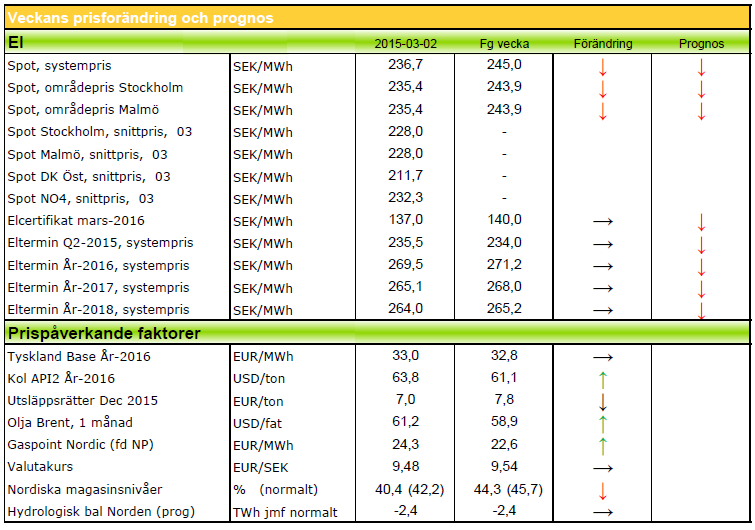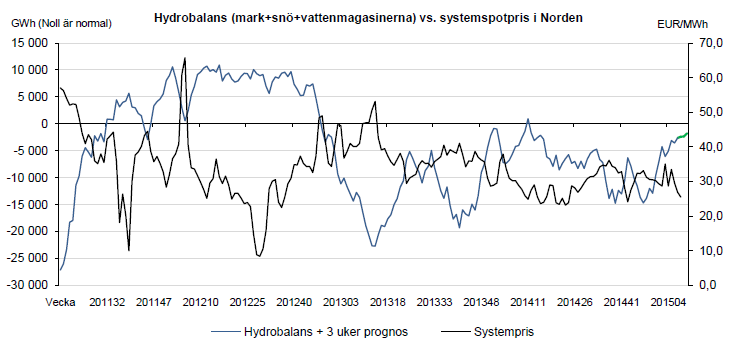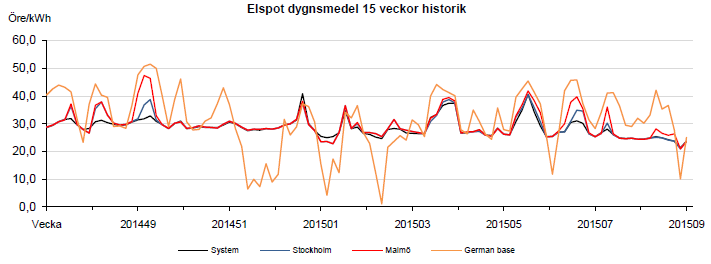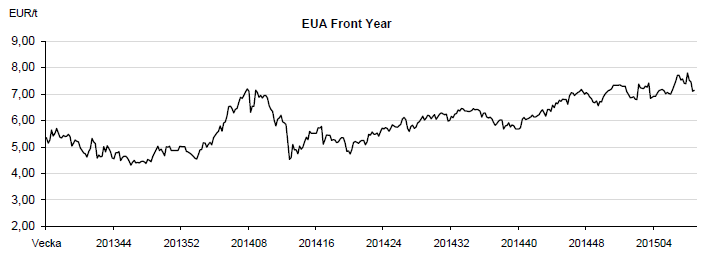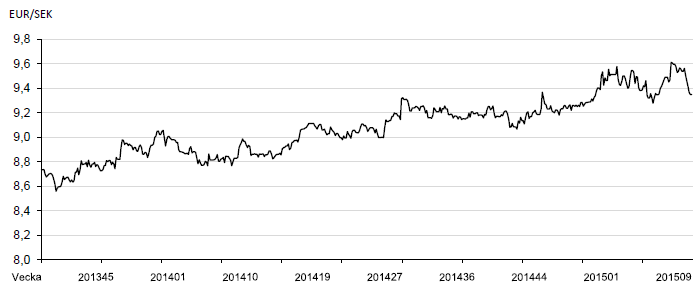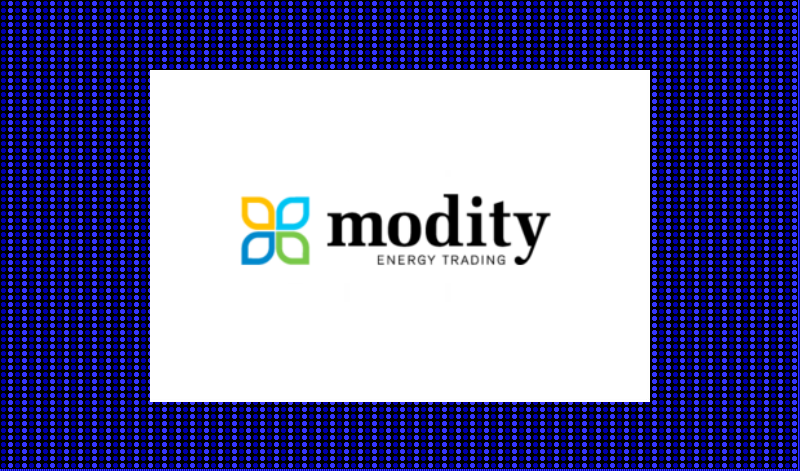Analys
Modity om elpriset vecka 10 2015
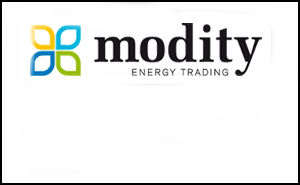
Veckans marknadskommentar
Brents uppgång har mattats medan WTI har vänt ned igen. Kolet upp en aning. Elen är upp på inte fullt så varma, blöta och blåsiga prognoser som förut. Utsläppsrätterna ned idag men trendkanalen är uppåt. Hydrobalansen blev starkare och är nu klart över normal nivå. Elcertens fall har pausat och stannat kvar på låg nivå.
Hydrobalansen ligger v08 på 1,4 TWh över normalen. Det är lite mindre än vad som var väntat och det beror på att den väntade påfyllningen från massiva lågtryck inte blev riktigt så stor, när de i stället vek av söderut. Avsmältningen på lägre nivåer har dock ökat och eftersom man fått balansera stor vindkraft så har vattenmagasinen byggts på en del under förra veckan. Fortfarande ligger det mycket snö högre upp, så totalt sett ser det alltså bra ut! Väderprognoserna har i viss mån ändrat karaktär mot det kallare hållet – åtminstone på kontinenten. Över Skandinavien är det fortfarande milt med aningen lägre nederbörd. Dock mer än normalt.
Kärnkraftverken i Norden har idag den 2/3 en produktion på 87 % (10 881 MW). Ringhals 1 kör nu aningen reducerat men väntas komma tillbaka upp under dagen. Annars är Oskarshamn 2 kvar ute till september och Ringhals 2 till november. De finska verken körs nu som vi är vana vid – 100 %.
Systemspotpriset förra veckan blev 25,52 €/MWh. Det var en tillbakagång på nästan tre euro. I prisområde SE3 blev den 25,34 och i SE4 26,73. Fortfarande ser vi press på vattenkraften. Systemet är känsligt i detta läge när magasinsnivåerna för sommaren och hösten behöver justeras lite nedåt men då vinden kräver återhållsamhet med vattnet, får det ju stanna kvar i magasinen så länge. I går visades några timmar med negativa siffror i DK2 på grund av stort vindtillskott.
Terminspriser
Och jag hann inte mer än säga ned innan det vände och började gå upp! Det var ett trendbrott i vädret som uppenbarade sig från mitten av förra veckan. Där syntes både lägre temperaturer och blockerande högtryck med lite nederbörd. Däremot var det en kortvarig uppenbarelse och strax därefter kom de våta, varma prognoserna med inrullande lågtryck från norra Atlanten tillbaka i prognosbilden. Där är vi nu. Priserna har följaktligen vänt ned igen. Inte ända ned till läget innan men nästan. Just idag har nederbörden i prognoserna dragits ned över perioden, så vi ser ett litet uppställ för närvarande. Som skrivet ovan är vattenläget gott och vi ser inga fundamentala faktorer som tyder på högre priser i dagsläget. Q2 omsätts i skrivande stund på 25,20. År 16 handlas nu på 28,80 €/MWh.
Bränslemarknaden
Utsläppsrätter, CO2
ENVI:s förslag gick igenom i tisdags, när omröstningen var. Det betyder i korthet att MSR ska vara fungerande senast 31 dec 2018. Detta kunde tydligen accepteras av alla parter och det innebär i praktiken en skärpning av nuvarande tidsschema. Marknaden reagerade lamt med fallande priser. Återstoden av veckan blev också en nedgång. Omsätts idag kring drygt sju euro. Tittar man på kursutveckingen i ett tekniskt analytiskt perspektiv är vi i en uppåtgående trendkanal.
Olja: Det är stor spread mellan amerikanska WTI-oljan och europeiska Brent. Brent prisas högre. För att det ska jämna ut sig krävs att USA bestämmer sig för att exportera sin olja genom att bygga rör, främst till Kanada. Detta verkar inte vara aktuellt för den sittande administrationen. Prissituationen är i stort sett sidledes men eftersom det är ett överutbud totalt i marknaden är antydan nedåt.
Kol: Australiensiska Glencore har annonserat en reduktion av sin kolproduktion. Något som stabliliserat priserna en aning och till och med fått dem att gå upp. Vi kan samtidigt se att torrfrakterna nu kostar mindre än på mycket länge, vilket håller nere konsumentpriserna. Fortfarande råder en överutbudssituation.
Naturgas: I England har man tagit ut den för uppvärmning lagrade gasen lite snabbare än vad som var tänkt. En kallare vinter har lett till en sådan åtgärd. Detta skulle normalt trigga en press uppåt på priserna i marknaden men man har lyckats ersätta mycket av volymen men billig LNG. I Ukraina är det förstås inte helt stabilt men landet har lyckats betala en del av den närmsta skulden man hade till Ryssland för levererad gas. Man försöker komma undan betalningsansvar för den del av gasen som gått till ryskdominernade områden. Ett understatement är att alla parter inte är helt överens i denna fråga..!
Elcertifikat
Efter förra veckans kraftiga nedgång har det stannat upp och hållit sig på den historiskt låga nivån. Lite oklart vad det var som gjorde nedgången så stor. Det har under förra veckan varit normal omsättning och senast är det en liten knorr uppåt i kursen. Mars -15 stängde i fredags på 137 SEK. Övriga priser: Mars-16 141 SEK och Mars-17 143,5 SEK.
Valuta
Valutakommentar
Som vi sa i senaste veckobrevet borde kronan stärkas mot euron och handla ner mot stödet på 9,30. Vi trodde inte att det skulle gå så snabbt men förra veckan stärktes kronan till 9,32 på anledning av den mycket starka BNP siffran som släpptes. BNP överraskade på uppsidan och steg 2,7% på årsbasis mot förväntat 1,5%. 9,30 förväntas hålla på nedsidan och vi handlar alltjämt i samma range som tidigare, 9,30 – 9,70. Mot dollarn är kronan alltjämt svag och man får betala 8,35 på spotmarknaden för en dollar. Vi har nu 11 månader bakom oss med högre bottnar och högre toppar. Rekyler är alltjämt köpvärda.
Teknisk analys
Teknisk analys Q2-15
Q2 handlades mellan 24,21 och 26,30 €/MWh förra veckan. Just nu handlas den på 25,15. Även om nedåttrenden är bruten så såg vi en kraftig avvisning av priset efter uppstället. Det är bearish och innebär att högre priser ansågs säljvärda och att marknaden nu kan komma att vilja testa botten av befintlig range, dvs 24,21. Ett test av botten av rangen kommer visa oss om den nivån fortfarande anses köpvärd eller om den ger vika för ännu lägre priser.
Teknisk analys År-16
År-16 handlades mellan 28,15 och 29,10 €/MWh förra veckan. Precis som för frontkvartalet så blev kontraktet avvisat efter att ha testat toppen av den €1-breda prisintervallet vi befinner oss i. Just nu omsätts 28,65 vilket är i mitten av rangen och det är inte helt omöjligt att marknaden nu vill handla ner mot botten på 27,95 även om det i nuläget är hugget som stucket vilket håll priset vill bryta ut. Det är en förhållandevis smal och lång range vilket innebär att när botten eller toppen väl bryts så kommer vi i snabb takt handla ner eller upp ett par Euro.
[box]Denna energimarknadskommentar om elpriset publiceras på Råvarumarknaden.se med tillstånd och i samarbete med Modity Energy Trading.[/box]
Ansvarsfriskrivning
Energimarknadskommentaren har producerats av Modity Energy Trading. Informationen är rapporterad i god tro och speglar de aktuella åsikterna hos medarbetarna, dessa kan ändras utan varsel. Modity Energy Trading tar inget ansvar för handlingar baserade på informationen.
Om Modity Energy Trading
Modity Energy Trading erbjuder energibolag och större företag den erfarenhet, kompetens och analysredskap som krävs för en trygg och effektiv förvaltning av energiportföljen. Modity bedriver handel med allt från el och gas, till elcertifikat, valutor och utsläppsrätter. Företagets kunder får dessutom ta del av deras analysprodukter som t.ex det fullständiga marknadsbrevet med ytterligare kommentarer och prognoser. För ytterligare information se hemsidan.
Analys
Diesel concerns drags Brent lower but OPEC+ will still get the price it wants in Q3

Brent rallied 2.5% last week on bullish inventories and bullish backdrop. Brent crude gained 2.5% last week with a close of the week of USD 89.5/b which also was the highest close of the week. The bullish drivers were: 1) Commercial crude and product stocks declined 3.8 m b versus a normal seasonal rise of 4.4 m b, 2) Solid gains in front-end Brent crude time-spreads indicating a tight crude market, and 3) A positive backdrop of a 2.7% gain in US S&P 500 index.

Brent falling back 1% on diesel concerns this morning. But positive backdrop may counter it later. This morning Brent crude is pulling back 0.9% to USD 88.7/b counter to the fact that the general backdrop is positive with a weaker USD, equity gains both in Asia and in European and US futures and not the least also positive gains in industrial metals with copper trading up 0.4% at USD 10 009/ton. This overall positive market backdrop clearly has the potential to reverse the initial bearish start of the week as we get a little further into the Monday trading session.
Diesel concerns at center stage. The bearish angle on oil this morning is weak diesel demand with diesel forward curves in front-end contango and predictions for lower refinery runs in response this down the road. I.e. that the current front-end strength in crude curves (elevated backwardation) reflecting a current tight crude market will dissipate in not too long due to likely lower refinery runs.
But gasoline cracks have rallied. Diesel weakness is normal this time of year. Overall refining margin still strong. Lots of focus on weakness in diesel demand and cracks. But we need to remember that we saw the same weakness last spring in April and May before the diesel cracks rallied into the rest of the year. Diesel cracks are also very seasonal with natural winter-strength and likewise natural summer weakness. What matters for refineries is of course the overall refining margin reflecting demand for all products. Gasoline cracks have rallied to close to USD 24/b in ARA for the front-month contract. If we compute a proxy ARA refining margin consisting of 40% diesel, 40% gasoline and 20% bunkeroil we get a refining margin of USD 14/b which is way above the 2015-19 average of only USD 6.5/b. This does not take into account the now much higher costs to EU refineries of carbon prices and nat gas prices. So the picture is a little less rosy than what the USD 14/b may look like.
The Russia/Ukraine oil product shock has not yet fully dissipated. What stands out though is that the oil product shock from the Russian war on Ukraine has dissipated significantly, but it is still clearly there. Looking at below graphs on oil product cracks the Russian attack on Ukraine stands out like day and night in February 2022 and oil product markets have still not fully normalized.
Oil market gazing towards OPEC+ meeting in June. OPEC+ will adjust to get the price they want. Oil markets are increasingly gazing towards the OPEC+ meeting in June when the group will decide what to do with production in Q3-24. Our view is that the group will adjust production as needed to gain the oil price it wants which typically is USD 85/b or higher. This is probably also the general view in the market.
Change in US oil inventories was a bullish driver last week.

Crude oil time-spreads strengthened last week
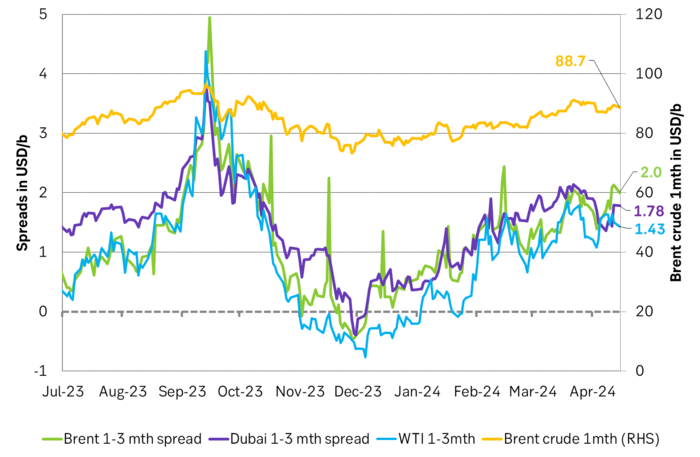
ICE gasoil forward curve has shifted from solid backwardation to front-end contango signaling diesel demand weakness. Leading to concerns for lower refinery runs and softer crude oil demand by refineries down the road.
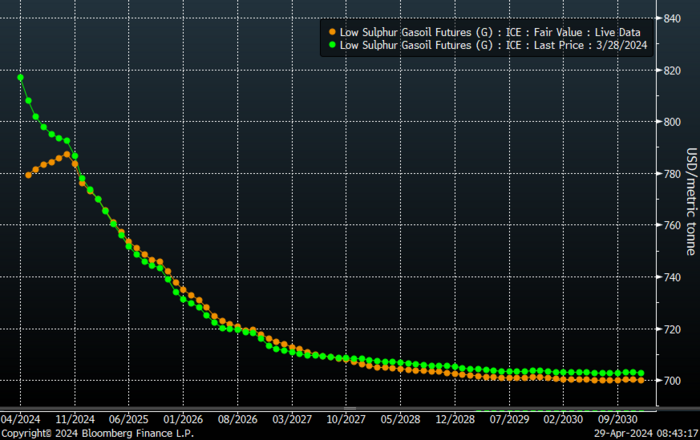
ARA gasoline crack has rallied towards while Gasoil crack has fallen back. Not a totally unusual pattern.
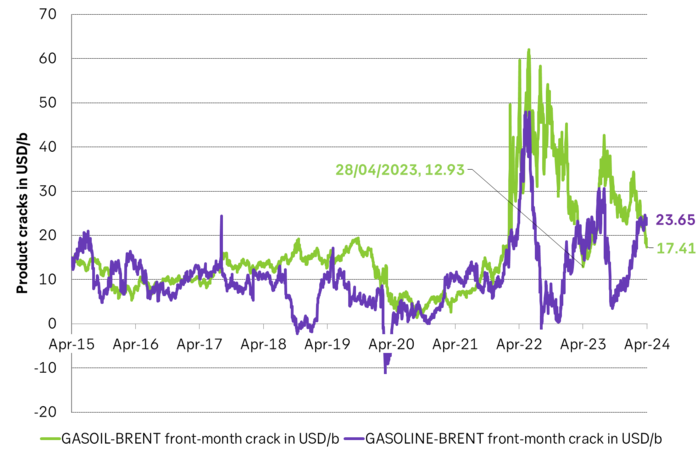
Proxy ARA refining margin with 40% gasoil crack, 40% gasoline crack and 20% bunker oil crack.

ARA diesel cracks saw the exact same pattern last year. Dipping low in April and May before rallying into the second half of the year. Diesel cracks have fallen back but are still clearly above normal levels both in spot and on the forward curve. I.e. the ”Russian diesel stress” hasn’t fully dissipated quite yet.
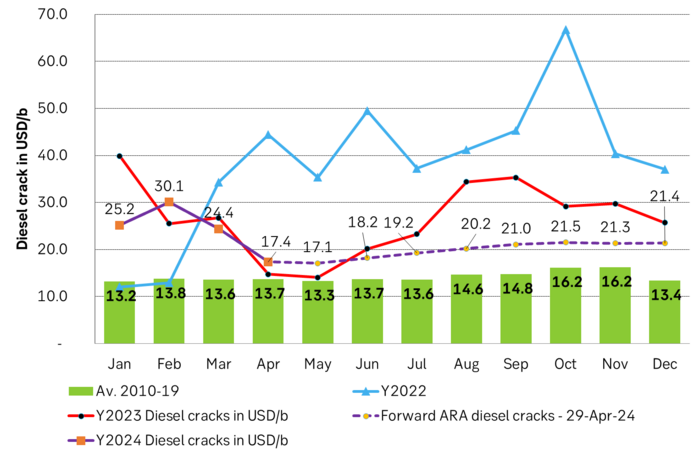
Net long specs fell back a little last week.

52-week ranking of net long speculative positions in Brent and WTI as well as 52-week ranking of the strength of the Brent 1-7 mth backwardation
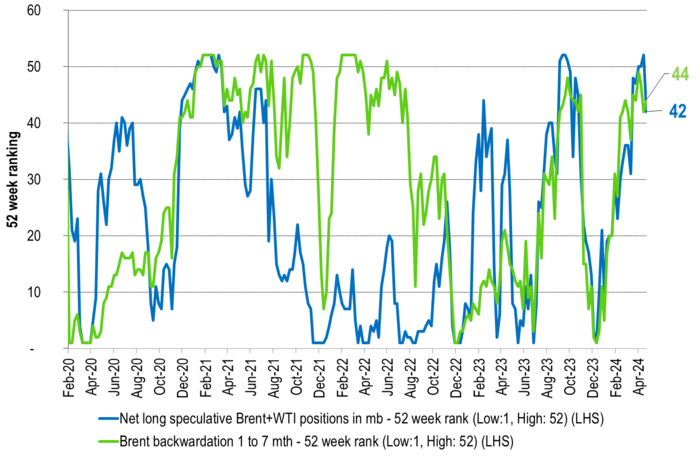
Analys
’wait and see’ mode

So far this week, Brent Crude prices have strengthened by USD 1.3 per barrel since Monday’s opening. While macroeconomic concerns persist, they have somewhat abated, resulting in muted price reactions. Fundamentals predominantly influence global oil price developments at present. This week, we’ve observed highs of USD 89 per barrel yesterday morning and lows of USD 85.7 per barrel on Monday morning. Currently, Brent Crude is trading at a stable USD 88.3 per barrel, maintaining this level for the past 24 hours.

Additionally, there has been no significant price reaction to Crude following yesterday’s US inventory report (see page 11 attached):
- US commercial crude inventories (excluding SPR) decreased by 6.4 million barrels from the previous week, standing at 453.6 million barrels, roughly 3% below the five-year average for this time of year.
- Total motor gasoline inventories decreased by 0.6 million barrels, approximately 4% below the five-year average.
- Distillate (diesel) inventories increased by 1.6 million barrels but remain weak historically, about 7% below the five-year average.
- Total commercial petroleum inventories (crude + products) decreased by 3.8 million barrels last week.
Regarding petroleum products, the overall build/withdrawal aligns with seasonal patterns, theoretically exerting limited effect on prices. However, the significant draw in commercial crude inventories counters the seasonality, surpassing market expectations and API figures released on Tuesday, indicating a draw of 3.2 million barrels (compared to Bloomberg consensus of +1.3 million). API numbers for products were more in line with the US DOE.
Against this backdrop, yesterday’s inventory report is bullish, theoretically exerting upward pressure on crude prices.
Yet, the current stability in prices may be attributed to reduced geopolitical risks, balanced against demand concerns. Markets are adopting a wait-and-see approach ahead of Q1 US GDP (today at 14:30) and the Fed’s preferred inflation measure, “core PCE prices” (tomorrow at 14:30). A stronger print could potentially dampen crude prices as market participants worry over the demand outlook.
Geopolitical “risk premiums” have decreased from last week, although concerns persist, highlighted by Ukraine’s strikes on two Russian oil depots in western Russia and Houthis’ claims of targeting shipping off the Yemeni coast yesterday.
With a relatively calmer geopolitical landscape, the market carefully evaluates data and fundamentals. While the supply picture appears clear, demand remains the predominant uncertainty that the market attempts to decode.
Analys
Also OPEC+ wants to get compensation for inflation

Brent crude has fallen USD 3/b since the peak of Iran-Israel concerns last week. Still lots of talk about significant Mid-East risk premium in the current oil price. But OPEC+ is in no way anywhere close to loosing control of the oil market. Thus what will really matter is what OPEC+ decides to do in June with respect to production in Q3-24 and the market knows this very well. Saudi Arabia’s social cost-break-even is estimated at USD 100/b today. Also Saudi Arabia’s purse is hurt by 21% US inflation since Jan 2020. Saudi needs more money to make ends meet. Why shouldn’t they get a higher nominal pay as everyone else. Saudi will ask for it

Brent is down USD 3/b vs. last week as the immediate risk for Iran-Israel has faded. But risk is far from over says experts. The Brent crude oil price has fallen 3% to now USD 87.3/b since it became clear that Israel was willing to restrain itself with only a muted counter attack versus Israel while Iran at the same time totally played down the counterattack by Israel. The hope now is of course that that was the end of it. The real fear has now receded for the scenario where Israeli and Iranian exchanges of rockets and drones would escalate to a point where also the US is dragged into it with Mid East oil supply being hurt in the end. Not everyone are as optimistic. Professor Meir Javedanfar who teaches Iranian-Israeli studies in Israel instead judges that ”this is just the beginning” and that they sooner or later will confront each other again according to NYT. While the the tension between Iran and Israel has faded significantly, the pain and anger spiraling out of destruction of Gaza will however close to guarantee that bombs and military strifes will take place left, right and center in the Middle East going forward.
Also OPEC+ wants to get paid. At the start of 2020 the 20 year inflation adjusted average Brent crude price stood at USD 76.6/b. If we keep the averaging period fixed and move forward till today that inflation adjusted average has risen to USD 92.5/b. So when OPEC looks in its purse and income stream it today needs a 21% higher oil price than in January 2020 in order to make ends meet and OPEC(+) is working hard to get it.
Much talk about Mid-East risk premium of USD 5-10-25/b. But OPEC+ is in control so why does it matter. There is much talk these days that there is a significant risk premium in Brent crude these days and that it could evaporate if the erratic state of the Middle East as well as Ukraine/Russia settles down. With the latest gains in US oil inventories one could maybe argue that there is a USD 5/b risk premium versus total US commercial crude and product inventories in the Brent crude oil price today. But what really matters for the oil price is what OPEC+ decides to do in June with respect to Q3-24 production. We are in no doubt that the group will steer this market to where they want it also in Q3-24. If there is a little bit too much oil in the market versus demand then they will trim supply accordingly.
Also OPEC+ wants to make ends meet. The 20-year real average Brent price from 2000 to 2019 stood at USD 76.6/b in Jan 2020. That same averaging period is today at USD 92.5/b in today’s money value. OPEC+ needs a higher nominal price to make ends meet and they will work hard to get it.
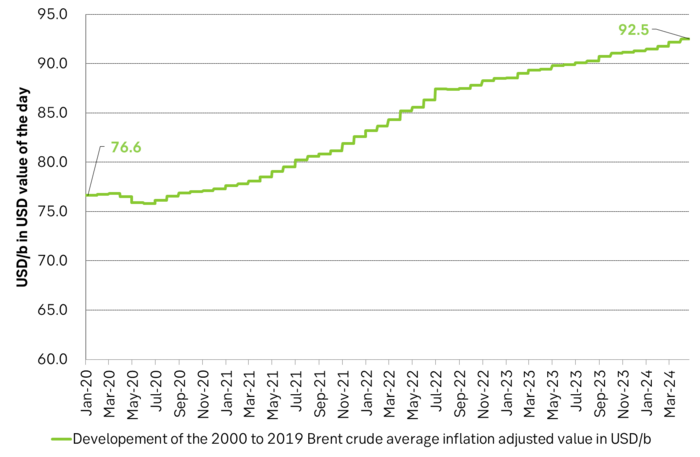
Inflation adjusted Brent crude price versus total US commercial crude and product stocks. A bit above the regression line. Maybe USD 5/b risk premium. But type of inventories matter. Latest big gains were in Propane and Other oils and not so much in crude and products

Total US commercial crude and product stocks usually rise by 4-5 m b per week this time of year. Gains have been very strong lately, but mostly in Propane and Other oils

Last week’s US inventory data. Big rise of 10 m b in commercial inventories. What really stands out is the big gains in Propane and Other oils
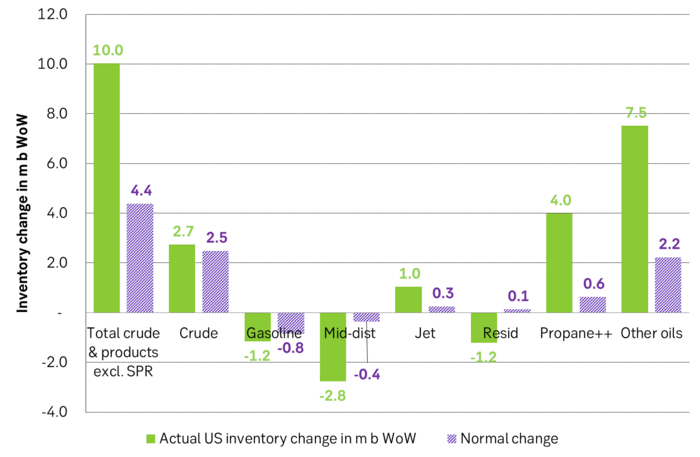
Take actual changes minus normal seasonal changes we find that US commercial crude and regular products like diesel, gasoline, jet and bunker oil actually fell 3 m b versus normal change.

-

 Nyheter4 veckor sedan
Nyheter4 veckor sedanGuldpriset når nytt all time high och bryter igenom 2300 USD
-
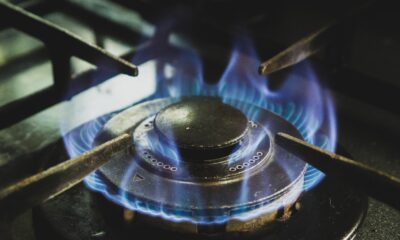
 Nyheter4 veckor sedan
Nyheter4 veckor sedanUSAs stigande konsumtion av naturgas
-

 Nyheter4 veckor sedan
Nyheter4 veckor sedanCentralbanker fortsatte att köpa guld under februari
-

 Nyheter4 veckor sedan
Nyheter4 veckor sedanKakaomarknaden är extrem för tillfället
-

 Nyheter4 veckor sedan
Nyheter4 veckor sedanHur mår den svenska skogsbraschen? Två favoritaktier
-

 Nyheter4 veckor sedan
Nyheter4 veckor sedanBetydande underskott i utbudet av olja kan få priset att blossa upp
-
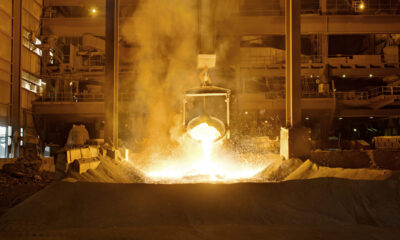
 Nyheter2 veckor sedan
Nyheter2 veckor sedanFortum och Vargön Alloys tecknar femårigt avtal om kärnkraftsel
-

 Analys2 veckor sedan
Analys2 veckor sedanBrace for Covert Conflict


